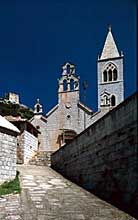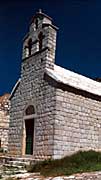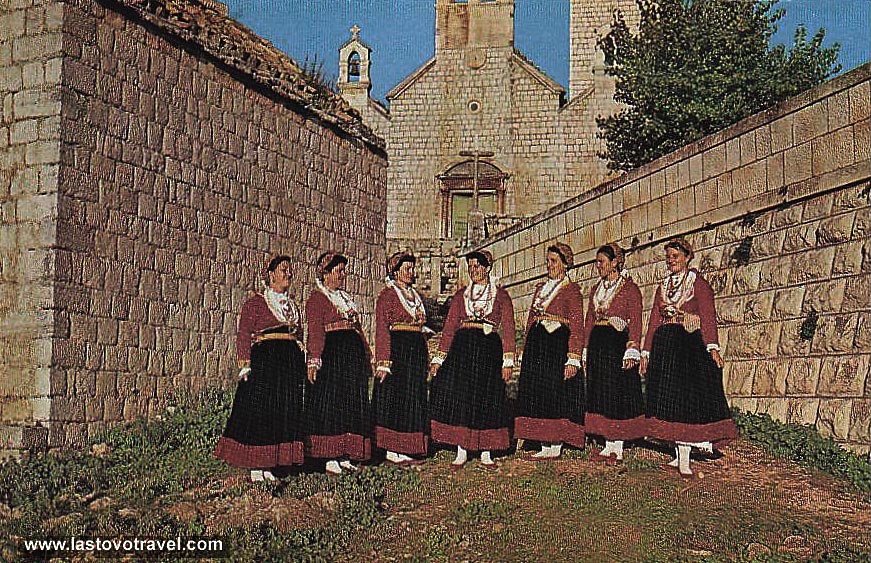History and Culture of Island of Lastovo

The main church at Lastovo island is the church of Saint Cosmas and Saint Damian, which the locals call the Lastovo cathedral. It is situated in the oldest part of the square in the town of Lastovo and dates from the 14th century. On the main altar is the painting of Saint Cosmas and Damian. Out of the rest of the paintings Pieta, the work of an anonymous Venetian painter from 1545, can be distinguished. In its place, there was a smaller church that dates back from the 5th or 6th century. The church of Saint Vlaho from the 12th century is at the entrance of the settlement. Beside it, the chapel of Saint John was built in 1607, and around the church defense wall and a tower.
On the graveyard on the southern edge is the little church of Saint Mary in the field from the 14th century and is considered as most attractive on the island. Near the ferry port in Uble (Ubli) the remains of a church dedicated to Saint Peter are situated. The church was built in the 6th century and was demolished in the 1930s during the construction of Fishermen’s village in Ubli.
One of the most recognizable features of the island are unique chimneys on the houses locals call fumari that resemble the minarets of the mosques. The tradition of building fumari dates back to the 17th century, when there was a need for better circulation of smoke during east wind, but also to express the uniqueness of the island. Since then, islanders were trying to make their fumar as recognizable and original as possible.
The most important event on the island is an authentic carnival locals call Poklad.
History of Lastovo (an extract)

The Byzantine emperor Constantine VII Porphyrogenitus mentioned Lastovo in the mid-10 century, but the first significant reference to Lastovo, connected with a historic event, happened in the year 1000. The Dodge of Venice, Pietro Orseolo II, during his raid of Dalmatia described by chronicler John the Deacon (Ivan Đakon) destroyed the fort and town at Lastovo as retaliation for the robbing of Venetian tradesmen and in order to secure free passage into the Mediterranean Sea. During the following two and a half centuries, Lastovo was to sink into total oblivion, and its inhabitants turned completely towards agriculture and cattle-raising, ignoring the earlier seafaring tradition.
In the mid-13th century (1252-1254) Lastovo voluntarily joined the Township of Dubrovnik, after the Township had taken the oath to let the inhabitants of Lastovo keep their ancient customs. The customary legal norms of Lastovo were replaced in 1310 by written regulations, which became the Community’s law once they had been adopted by the People’s Forum and confirmed by the Rector of Dubrovnik. (Read more about History of Dubrovnik)
The People’s Forum was the main authority on the island, having all legislative power and consisting of 20 counselors holding office for life. The executive power was invested in the Rector and three magistrates elected by the people. Public officials were notaries (priests), chamberlains (kamerlenzi ), guards, messengers ( placari ), vineyard guards ( pudari ), emissaries, market inspectors ( iusticieri ) and assessors.
After February 28, 1358, when the Venetian protectorate of Dubrovnik ended, King Louis I gave the Dubrovnik Township exclusive powers over Lastovo. Even in those new circumstances, the autonomous life of the Lastovo Community went on without special limitations. In the second half of the 15 th century, however, Dubrovnik started to interfere with the autonomous life of the island, the Forum lost its legislative powers to the Republic’s Council in 1486, and the old regulations of the Statute were less applied.
The apparent increase in the limitation of the island’s self-government, as well as the arbitrary imposition of additional burdens on the inhabitants by the Dubrovnik authorities (increasing the Rector’s salary, guard duty, prison building), led to a soon crushed bloody rebellion in 1602. In the next year, Lastovo was occupied by Venice at the invitation of the rebels, to be returned to the Dubrovnik republic only in 1606. Another rebellion was attempted in 1652 when the district of Lastovo was to return a sum of 200 gold pieces spent in a lawsuit with Venice for the protection of the sovereignty of Sušac.
Lastovo, inhabited (according to an estimate by chamberlain and rebel Don Kuzma Antica) by more than 1000 inhabitants again offered itself to Venice, but the Venetian government refused the offer so that there was no actual rebellion. Lastovo never gained anything from the rebellions; furthermore, it lost its autonomy altogether, became part of the Dubrovnik territory and became subject to most of the legal acts passed by the Republic’s bodies.

As the Turks advanced to the sea, Lastovo its property and especially its fishing fleet became a target for marauders, mainly from the Ulcinj region. The looting became more often during the 1 st and 2nd Holy Leagues in the 16th century, and during the Wars for Candia and Morea in the 17th century when the Lastovo inhabitants were obliged to stand guard in order to defend the island. Only in the 30s of the 18th century did the piracy of the Ulcinj people stop, as they increasingly turned towards naval trade, and this put a stop to guard duty on the island.
On the eve of May 27, 1806 Napoleon’s troops entered Dubrovnik and gradually took the entire territory of the Republic, which dissolved two years later on January 31, 1808. The French built a fortress on Lastovo on the hill of Glavica and organized the islanders in the National Guard for the protection against English Corsairs confiscating their ships. The English, on the other hand, took Lastovo attacking from the island of Vis on January 28, 1813, and kept it under their rule till July 16, 1815, when, according to a decision of the Vienna Congress, they gave the island over to Austria.
From 1818, Lastovo as part of the Dubrovnik County had the status of District with a praetura and a praetor presiding. The praetura was dissolved in 1829, when Lastovo as a rural district headed by a syndicus ( sindak ) became part of the District of Korčula, The heads were native landowners, while the secretaries were mostly foreigners. In the 40’s of the 19 th century the rural district’s administration was forced to sell the best woodlands to private owners, due to lack of funds. The District Council of Korčula dissolved the rural district’s administration in 1905 and appointed Antun Šantić-Ćihoratić, Ph.D., as commissioner. At the local elections in the following year Janko Lucianović was elected head of the rural district, a duty he was going to perform till the fall of Austria in 1918.
The Italian occupation of Lastovo on November 11, 1918, was a result of the secret Treaty of London signed in 1915 by Italy and the Triple Entente. The annexation of Lastovo by the Kingdom of Italy was based on the Treaty of Rapallo of November 12, 1920, after which the district became part of the District of Zadar. The Italian rule over Lastovo was characterized by quenching the national identity, an apparent increase in the number of inhabitants, significant building activity and an improvement in the standard of living. September 8, 1943, Italy’s capitulation in WWII, was the end of the Italian rule over Lastovo.
Read about other Islands in Croatia
Author of History of Lastovo extract: Antun Jurica, “Lastovo kroz stoljeca”